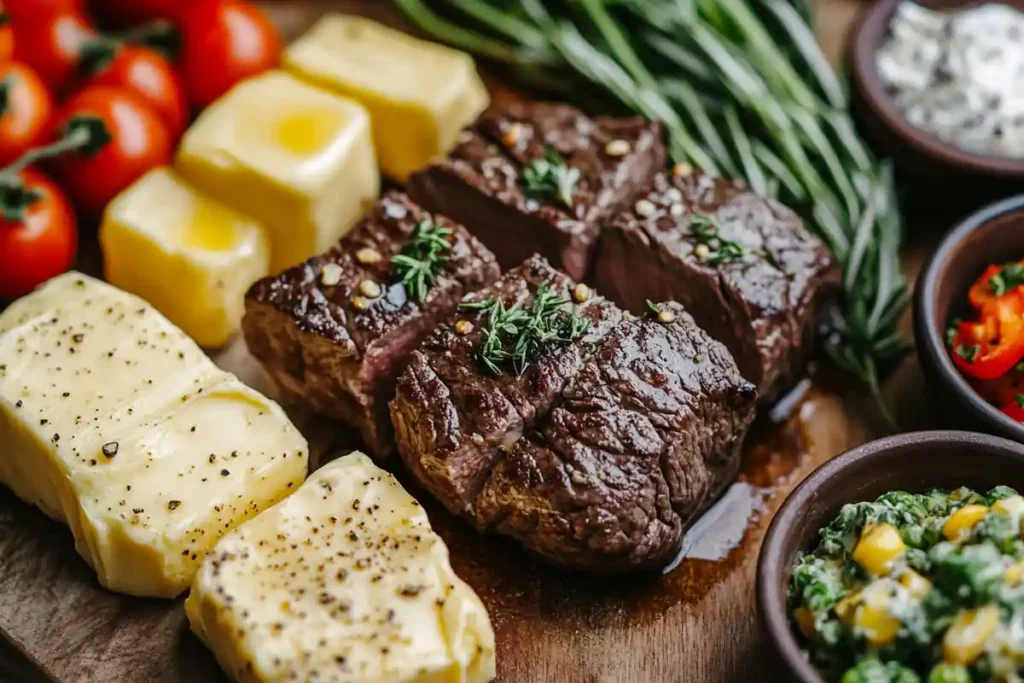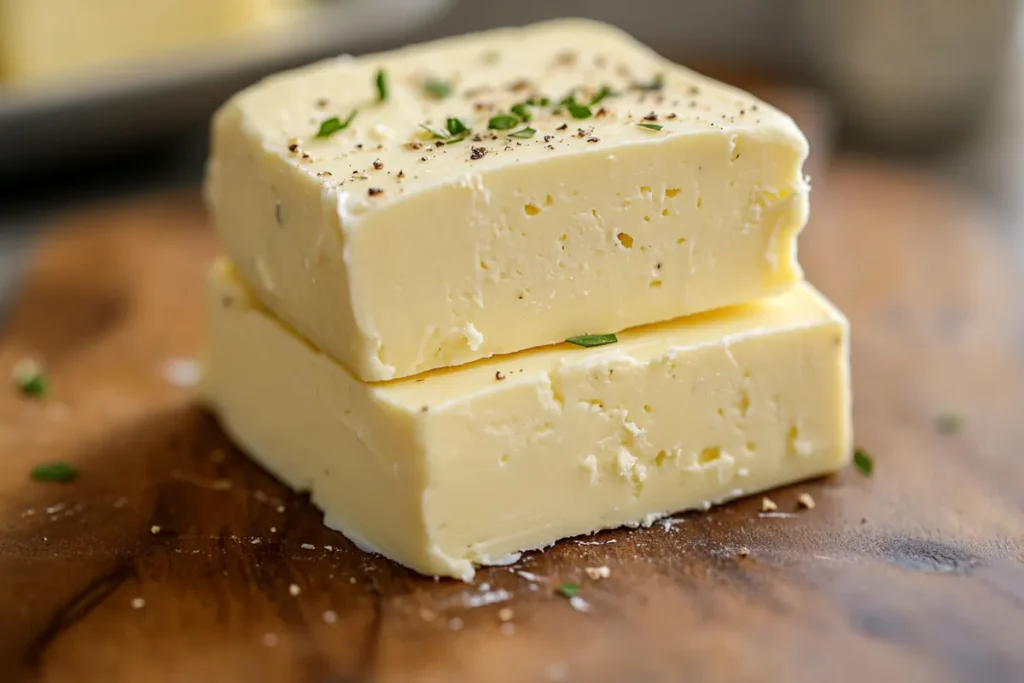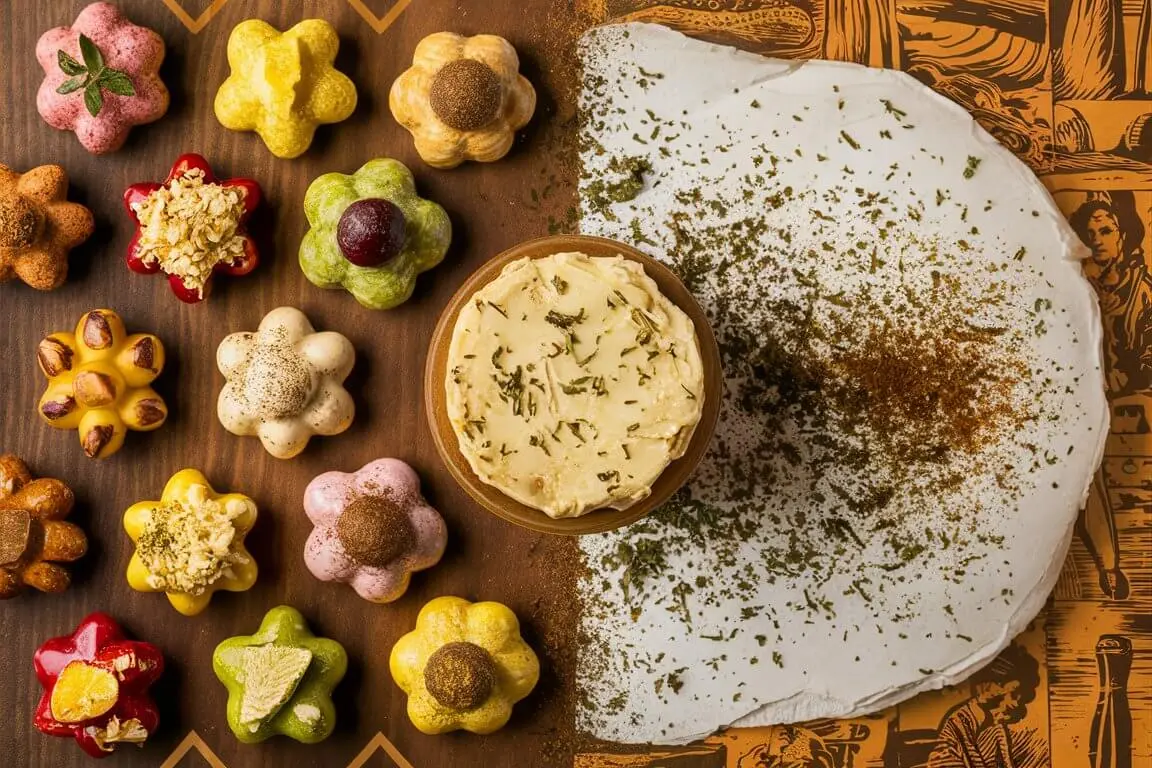Table of Contents
What is the Difference Between Cowboy Butter and Compound Butter? A Detailed Overview

Many people enjoy flavorful butters. Two popular choices are cowboy butter and compound butter. However, despite both being flavored butters, key differences exist. So, let’s delve into their unique characteristics, uses, and how they can enhance your meals.
Exploring the Basics: What is Compound Butter?
First, let’s examine compound butter. Essentially, it is regular butter mixed with other elements. Typically, these elements include herbs, spices, and sometimes even fruits or zest. Therefore, it’s a broad term for any butter that has been enhanced. For example, a simple garlic butter is a basic compound butter. Furthermore, there are many ways to create this type of butter based on your taste.
Key Components in Making Compound Butter
A few simple things make up compound butter. The main item, of course, is butter. It’s usually unsalted butter, which provides a neutral base. Next, you will add the flavor elements. These could include fresh herbs, dried spices, citrus zest, or even roasted garlic. Additionally, you can use a bit of salt and pepper. Finally, you will mix everything to blend well.
Common Applications: Using Compound Butter in Cooking
This type of butter is very adaptable. Therefore, it has many uses in cooking. It’s amazing on top of steaks, chicken, or fish. Moreover, it can elevate simple toast or bread. Furthermore, you can melt it over steamed or roasted vegetables. Also, it’s great for adding a final touch to pasta dishes. Ultimately, the goal is to add extra flavor to almost anything.
Delving into Cowboy Butter: A Unique Flavored Butter

Now, let’s focus on cowboy butter. At its core, it is a type of compound butter. However, it has a very distinct flavor profile. It has many herbs and spices, usually including a bit of heat. Specifically, it is a robust, more intense flavored butter. Accordingly, it stands out from other flavored butters. This butter aims to add a bold, “cowboy” kick to your food.
Unique Traits of Cowboy Butter: Understanding its Composition
What makes cowboy butter unique? Chiefly, it’s the blend of ingredients. Generally, it includes a mix of herbs like parsley, thyme, and chives. Additionally, you’ll find spices such as garlic powder, onion powder, and red pepper flakes. Moreover, citrus zest, often lemon or orange, adds brightness. Also, some variations include Dijon mustard for a tang. Finally, everything is combined to provide a multi-layered flavor experience.
Flavors Unveiled: What is the Difference Between Cowboy Butter and Compound Butter?
In flavor, the differences between these butters are significant. Compound butter has varieties of flavors. It can be savory, sweet, or spicy. However, cowboy butter always has a bold, savory flavor. Consequently, it’s typically a more complex flavor, always with a hint of heat. So, while both add flavor to meals, they offer very different tasting experiences. Therefore, they should be selected accordingly.
Key Distinctions: Comparing Ingredients of Flavored Butters
When we focus on ingredients, the differences are notable. While compound butter is flexible, cowboy butter has a set list. Compound butter might use only one herb or spice. Cowboy butter, however, has multiple herbs, spices, and some citrus. In addition, some recipes might have Worcestershire sauce. This is not typical in standard compound butter. Ultimately, the ingredient list explains their different flavors.
Ingredient Flexibility: The Variety in Compound Butter Components
This type of butter’s variations are virtually limitless. You could create an herb butter with rosemary and thyme. Alternatively, you could make a sweet butter with honey and cinnamon. Furthermore, some can have sun-dried tomatoes. Basically, the ingredients are chosen to complement the food. Thus, it’s highly customizable based on your specific needs.
Signature Elements: The Distinctive Components of Cowboy Butter
Cowboy butter, conversely, has more fixed ingredients. The combination is what makes it unique. Specifically, the dried spices offer depth. The citrus zest adds a fresh note. Additionally, the red pepper flakes bring the heat. Therefore, each element is vital for its distinctive taste. Chiefly, it’s the mix of all these components that creates its special flavor.
Differences in the Process: Understanding Butter Preparation
Another aspect is the preparation. Compound butter preparation is straightforward. You simply mix the ingredients into softened butter. Then, you shape it as you prefer and chill it to let it firm. However, both butters are prepared the same.
Simple Steps: How to Prepare Compound Butter
The process of making compound butter is simple. First, soften your butter. Then, add your chosen ingredients. Next, mix well with a fork or spoon. After that, place the mixture on some parchment paper or plastic wrap. Finally, roll it into a log, then refrigerate. So, making this butter is a very quick and easy task.
Similar Methods: Preparing Cowboy Butter at Home
Similarly, this also involves mixing softened butter. You will blend the listed herbs and spices. Likewise, the citrus zest is added for a fresh tang. Moreover, you will mix everything until well combined. Finally, shape the butter into a log or disc, then chill. Therefore, both preparation methods are similar, but the flavor profiles differ.
What is the Difference Between Cowboy Butter and Compound Butter?: Culinary Applications Explored
In terms of how you use them, this butter is extremely versatile. You can use it to add simple flavor to any dish. However, cowboy butter has a more specific flavor. Thus, it’s best paired with foods that can handle its boldness.
Adaptable Uses: The Versatility of Compound Butter in Recipes
Compound butter is amazing because of its adaptability. For example, you can use a simple herb butter on baked potatoes. Additionally, you can use a lemon-dill butter for fish. Moreover, you can enhance the taste of roasted chicken with a rosemary butter. Ultimately, this butter can be adjusted to enhance almost any flavor.
Best Matches: Specific Uses for Cowboy Butter in Meals
Cowboy butter, conversely, shines when used with bold flavored foods. Specifically, it’s great on grilled steak or lamb chops. Furthermore, it’s perfect to enhance the taste of barbecued ribs. Also, it adds a special kick to burgers or baked potatoes. Chiefly, it is great for any dish that needs a flavor boost. Therefore, choose the butter that compliments the food.
Preserving Flavors: Understanding Butter Storage Techniques
Another key aspect is storage. Both butters should be stored in the same way. Generally, they should be kept in an airtight container. This will preserve their taste and freshness. Moreover, both butters last equally when stored correctly.
Storage Tips: How to Keep Compound Butter Fresh
Compound butter should always be stored in the refrigerator. It needs to be kept in an airtight container or wrapped well in plastic wrap. This helps to prevent it from picking up other fridge odors. Also, you can freeze this butter for extended storage. Indeed, freezing is perfect for preserving it.
Best Practices: Storing Cowboy Butter for Optimal Freshness
Similarly, this also needs to be refrigerated or frozen. Make sure it is kept in an airtight container or wrapped in plastic wrap. Additionally, freezing works well. Specifically, both butters keep for a few weeks in the refrigerator. Thus, you can easily prepare them in advance.
Flavor Profiles: How These Butters Impact Dishes
Ultimately, the impact on dishes comes down to the flavor. Both enhance dishes. However, they do so in different ways. Compound butter can be subtle. Cowboy butter, on the other hand, is always bold and makes a statement. Therefore, you should choose the flavor that matches your needs.
Subtle Enhancements: The Delicate Touch of Compound Butter
Compound butter is a versatile flavor enhancer. For example, a delicate herb butter adds a fresh note to grilled fish. Additionally, a sweet butter can complement pancakes or waffles. Moreover, this butter can add a gentle flavor to the dish. Thus, it’s a versatile option for subtle taste improvements.
Bold Statements: The Impact of Cowboy Butter on Meals
Cowboy butter is all about making a statement. Specifically, it adds a strong, savory, and spicy flavor. Therefore, it’s perfect for dishes that need a bold touch. In addition, it adds a smoky flavor, thanks to its spices. Accordingly, it is great when you want to elevate a meal with a flavor kick.
Summing Up: Key Differences Between These Two Types of Butter
In summary, compound butter is the broader category. It includes any butter mixed with other flavors. Cowboy butter, however, is a specific type of compound butter. It always features a bold, savory, spicy flavor profile. Both butters have many uses. Furthermore, they both make cooking more enjoyable. Therefore, understanding these differences helps you make informed culinary choices.
Tracing Back: The History of Flavored Butters
Before we dive deeper, it’s helpful to know where the idea of flavored butters came from. Basically, the practice of adding herbs and spices to butter goes back centuries. People have always tried to improve the flavor of food. Therefore, it is part of a long culinary tradition. Understanding this can help you appreciate these butters more.
Ancient Practices: The Historical Roots of Compound Butter
The concept isn’t new. Chefs and home cooks have been experimenting with butter for a long time. Initially, it was a way to preserve herbs during the harvest season. Butter helped to keep the flavor of herbs and spices for later use. Thus, it has roots in practical food preparation.
A Modern Twist: The Evolution of Cowboy Butter
Cowboy butter, conversely, is a more recent addition. It likely originated in the American West. It was likely a way to add more flavor to basic campfire cooking. Specifically, the spices and herbs reflected the available ingredients. Also, it aligned with the bold flavors of Western cooking. Hence, it represents a newer, more specific culinary style.
Elevating Your Flavors: Tips for Making the Best Butters
Making great compound butter or cowboy butter is not hard. However, there are a few tricks to make them even better. First, use high-quality unsalted butter. Next, choose fresh, high-quality herbs and spices. Finally, blend everything well and store it correctly. These simple tips will help you create amazing flavorful butters every time.
Must-Know Advice: Essential Tips for Making Compound Butter
When making this type of butter, always start with softened butter. It is easier to mix in the flavorings. Moreover, chop your herbs finely. This helps to release the maximum flavor. In addition, don’t be afraid to experiment with flavors. Finally, taste as you go, so that you adjust as needed. Therefore, these small steps can make a big difference.
Perfecting the Recipe: Essential Tips for Making Cowboy Butter
For cowboy butter, focus on getting the right balance of flavors. Specifically, don’t overdo it on any one spice. Furthermore, use fresh citrus zest for the best flavor. Also, some recipes call for a bit of Worcestershire sauce. Indeed, adding it can give a savory boost. Ultimately, balance is key to the perfect butter.
Serving Ideas: How to Best Present Flavored Butters
In how they are served, compound butter can be used both as a cooking ingredient and as a finishing element. Cowboy butter, conversely, is usually a finishing touch. Therefore, the serving style depends on the specific butter.
Versatile Presentations: Serving Suggestions for Compound Butter
This type of butter is highly versatile in its serving options. For example, you can place a pat of herb butter on a grilled steak. Additionally, you can melt a lemon-dill butter over steamed fish. Moreover, you can spread a sweet butter on toast or pancakes. Thus, it’s adaptable to numerous serving needs.
Finishing Touches: Best Ways to Serve Cowboy Butter
Cowboy butter is best served as a finishing touch. Specifically, add a dollop on top of a freshly grilled steak. Furthermore, it can enhance the flavor of a burger or a baked potato. Also, it can be used to add flavor to roasted vegetables. Chiefly, its bold flavor makes it a great choice for finishing meals. Therefore, consider the dish when deciding on the best use.
Complementary Flavors: Perfect Pairings with Flavored Butters
Another consideration is how well they pair with various foods. Compound butter is adaptable and pairs with many types of foods. However, cowboy butter is more specific in its flavor. Consequently, it pairs best with bolder dishes.
Compatible Dishes: Ideal Pairings for Compound Butter
This type of butter’s adaptability makes it easy to pair with foods. For example, herb butter pairs with chicken or fish. Additionally, lemon-dill butter is great with seafood. Moreover, cinnamon butter complements sweeter dishes. Basically, you can match the butter to the dish. Thus, the options are endless.
Bold Pairings: Ideal Dishes for Cowboy Butter
Cowboy butter is best paired with bold, savory dishes. Specifically, it works well with steak and lamb chops. Furthermore, it can be used on barbecued ribs. Also, it complements potatoes and burgers. Chiefly, it stands out with rich, substantial flavors. Therefore, it’s a great choice for meals that need a kick.
Personalizing Your Recipes: Making Flavored Butters Your Own
One of the joys of cooking is personalization. Therefore, you can adjust both recipes to fit your taste. You can adjust the herbs, spices, and other elements to create a butter that suits your preferences. This makes the butters even more versatile and enjoyable.
Customization Options: Personalizing Your Compound Butter Recipes
Making this type of butter is all about personalization. For example, if you love garlic, add more garlic. Additionally, if you prefer a sweeter taste, try honey or cinnamon. Moreover, try adding different zests, like lime or grapefruit. Thus, you have full control of the final product. Ultimately, it’s about crafting the taste that you love.
Flavor Adjustments: Personalizing Your Cowboy Butter Recipes
Even this can be personalized to your liking. Specifically, adjust the amount of red pepper flakes to control the heat. Furthermore, try using different herbs for subtle changes. Also, you can add different kinds of citrus zest. Indeed, experimenting is the best part. Therefore, feel free to adapt the recipe to your preferences.
Practical Scenarios: When to Choose Which Type of Butter
Let’s consider this in practical cooking scenarios. Compound butter is the more adaptable option. It works well in many recipes. Cowboy butter, conversely, is better for specific situations. It works best when a bold flavor is wanted. Thus, each has its advantages in specific cases.
Everyday Cooking: When to Choose Compound Butter
This type of butter is great when you want to add subtle flavors. It’s very good when used to enhance simple dishes. For example, it is great for melting over grilled fish or baked vegetables. Furthermore, it can be used to add a twist to breakfast. Basically, it’s a versatile option when you want to add any flavor.
Bold Dishes: When Cowboy Butter Shines
Cowboy butter is ideal when you want to make a bold statement. Specifically, it’s great for grilled meats. Also, it’s perfect for boosting the taste of hearty meals. Additionally, it works well in any situation that needs bold flavor. Thus, it’s ideal for enhancing your favorite, savory dishes. Ultimately, use it when you want to elevate the taste.
Conclusion
Understanding the differences is crucial for home cooks and chefs. While both add flavor, cowboy butter stands out because of its specific ingredients and intense flavor profile. Compound butter, however, is more versatile. Ultimately, knowing each butter’s qualities allows you to pick the best one for your meals. Thus, choosing between them depends on your flavor preferences.
Frequently Asked Questions (FAQs)
What is cowboy butter made of?
Cowboy butter is generally made of unsalted butter, fresh herbs like parsley, thyme, and chives, along with spices such as garlic powder, onion powder, and red pepper flakes. It may also include citrus zest and sometimes Dijon mustard or Worcestershire sauce.
What is the difference between butter and compound butter?
Regular butter is simply churned cream, whereas compound butter is butter that has been mixed with additional elements like herbs, spices, or flavorings to enhance its taste. Therefore, compound butter is the flavored variation.
Why do chefs use compound butter?
Chefs often use compound butter to add layers of flavor and complexity to dishes easily. It offers a quick and effective way to boost the taste of a variety of foods, from steaks and fish to vegetables and bread. Additionally, it allows for creative culinary exploration.
What is the difference between the different types of butter?
The primary difference between the types of butter lies in processing and flavor. Unsalted butter has no added salt. Salted butter has added salt. Additionally, cultured butter has added bacteria. Finally, clarified butter has the milk solids and water removed. Therefore, they are all different and used for specific purposes.

